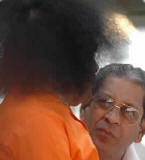
Home | SBOI-Group| Pictures | Audio-Video | Wallpapers| Greeting-cards | Ashrams Info. | Sai news
The
Kodaikanal Experience -
Part I
Part II -
Part III
Rendezvous with Prof. Anil Kumar
Related Anil Kumar & Kodaikanal resource
Kodaikanal Resource: Kodaikanal Ashram - detailed Info & photos
![]()
![]()
![]()
Introduction
It is said that
Prasanthi Nilayam is Swami’s office, Brindavan is His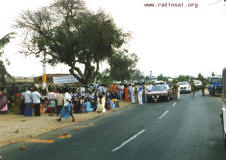 home and Kodaikanal is His playground.
In a manner of speaking, this is so particularly where Kodaikanal is concerned,
for it is here, that one gets a glimpse of the Sai of the Forties, especially
where Divine Leelas are concerned. It all lasts only a few weeks, but what
extraordinary weeks they are, for those blessed to enjoy Divine intimacy then!
home and Kodaikanal is His playground.
In a manner of speaking, this is so particularly where Kodaikanal is concerned,
for it is here, that one gets a glimpse of the Sai of the Forties, especially
where Divine Leelas are concerned. It all lasts only a few weeks, but what
extraordinary weeks they are, for those blessed to enjoy Divine intimacy then!
Kodaikanal is a
hill station in South India about four hundred and odd kilometres south east of
Bangalore and near the Temple Cities of Madurai and Palani. In former years,
every summer Swami used to take a few selected students with Him to Kodai. To
help you to know more about Swami’s Kodai sojourn, we reproduce below the
transcript of a dialogue between Prof.Anil Kumar and Prof. Venkataraman,
broadcast earlier over Radio Sai. Both are from the SRI SATHYA SAI INSTITUTE OF
HIGHER LEARNING.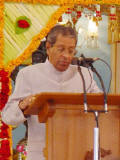
GV: Anil Kumar Garu, welcome to the Studios of Radio Sai. Normally I begin by asking our visitors or guests to introduce themselves. In your case, however, this is obviously not necessary. I would not say you are next only to GOD, but you certainly stand next to GOD so often [!] that most people know you for sure. Nevertheless I think most of us don’t know how you first came to Swami. So may be, you could tell us very briefly how you came to Swami. We want to know how He pulled the string in your case and brought you close to Him.
AK: I am Anil Kumar from the State of Andhra Pradesh and I belong to BRAHMA SAMAJ, founded by Rajaram Mohan Roy. Our families have been following this faith, Brahma Samaj, for the last three generations.
GV: What is special about this Brahma Samaj?
AK: BRAHMOS don’t practice idolatry. A follower of this Samaj believes in fellowship of faiths and congregational worship. The Brahma Samaj does not accept class or the caste system. It believes that all religions are equal. It works for women’s emancipation.
GV: So, everything that is said in Vedanta is there in this philosophy?
AK: Yes, and that is why the founder Rajaram Mohan Roy is sometimes called the Prophet of Modern India. Both my grandfathers happened to Brahmo missionaries who dedicated their entire lives for this cause. I came to Swami for the first time in 1970 because of some problem at home. My wife was sick and I took her round to thirteen doctors, and spent thousands of rupees. But after coming to Swami, she had a total cure. Being interested in philosophy since my childhood, thanks to my grand father, I then started reading SAI literature and soon I found that Baba explains Brahma Samaj ideals better than the founder Rajaram Mohan Roy himself! As a result, I am a better Brahmo now than ever before.
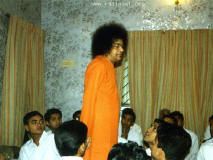 GV:
Yes, that is what Swami always says: Be a good Christian, be a good Muslim, be a
good Jew etc. Now, you are a very good teacher and you also know a lot about how
Swami as the Supreme Teacher moulds students. So I am going to ask some
questions relating to that. In particular I want you to share with all our
listeners, the thrilling experience about Kodaikanal. It is said that Kodaikanal
is Swami’s playground whereas Prasanthi Nilayam is His office and Brindavan is
His home. How many times have you have been to this playground?
GV:
Yes, that is what Swami always says: Be a good Christian, be a good Muslim, be a
good Jew etc. Now, you are a very good teacher and you also know a lot about how
Swami as the Supreme Teacher moulds students. So I am going to ask some
questions relating to that. In particular I want you to share with all our
listeners, the thrilling experience about Kodaikanal. It is said that Kodaikanal
is Swami’s playground whereas Prasanthi Nilayam is His office and Brindavan is
His home. How many times have you have been to this playground?
AK: At least six times.
GV: That is very good and I suppose many more trips are in store for you.
AK: Thank you sir.
GV: The Kodai trip seems to be an extraordinary event and with a special purpose too. Why don’t you tell us all about the Kodaikanal trip, starting from the beginning?
AK: Well Sir, Swami selects students for the trip, and the selection is based on all aspects of their performance in the college - academic, conduct, devotion, excellence in sports and games, talent for singing and dramatics as well. All talented students who are also highly devoted are selected by Bhagavan to follow Him. A few teachers are also included in the party. Kodaikanal is such a beautiful place. If I am to say how paradise would be, well, that could not be anything other than Kodaikanal.
GV: When does Swami go to Kodaikanal, typically?
AK: Usually He leaves in early April; and He returns by 5th of May. So roughly speaking, He spends about a month in Kodaikanal. But there have been occasions when He stayed on 6th of May also and celebrated ESWARAAMMA DAY there, in Kodaikanal. It happened twice I believe. Kodaikanal is most interesting because Swami is very, very close to the boys and they can learn many, many things from Swami.
GV: I suppose boys are also very close to Swami.
AK: Very, very intimate.
GV: Typically, how many hours a day is Swami with them?
AK: Sir, immediately after breakfast He spends an hour with them. After that, Bhagavan goes out to give Darshan to the devotees and grants them interviews. During this time, the boys go around the lake a bit and they return by 9:30. From 9:30 to 11 O’clock Swami again talks to the boys, after which lunch follows. Next we have tea around 2 O’clock. Swami talks to boys again from 2:30 to 4 O’clock. From about 4 to 5 P.M there is a public meeting which the boys also attend. After the public meeting, Swami talks to students and some select devotees, which is something like an echo session – the evening meeting is reviewed.
GV: Public meeting means Discourse also?
AK: Yes of course; the Discourse is given in the Bhajan Hall of Sai Sruthi, Swami’s Mandir in Kodai.
GV: So, from morning till evening, Swami is talking all the time?
AK: At least five Discourses a day!
GV: My God!
AK: Four of these Discourses are exclusively for students. Besides, it is wonderful to see how Swami treats the boys. He enquires about their family, their brothers and so on.
GV: OK, let us go over the details and start from Bangalore - He always starts from Bangalore, right? It must be pretty exciting to go all the way from Bangalore to Kodaikanal. Tell us everything about the trip from Bangalore to Kodaikanal.
AK: The student party travels in a big air-conditioned van, with cushioned seats that can recline. Swami tells all the boys to get into the van, which is loaded with sweets and eatables of all kinds, apart from fruits in plenty. One can go on eating until one reaches Kodaikanal, neck deep. During the journey to Kodaikanal, Bhagavan halts at not less than fifteen to twenty places. This is because the State of Tamil Nadu in which Kodai is located, is full of Sai devotees all over. Every village in Tamil Nadu has a SAI centre. Along the highway, devotees raise huge pandals and sit there singing Bhajans while waiting for Baba. Swami stops, gets down from His car, blesses all devotees, makes a quick round, receives Aarathi and the gets back into His car.
GV: Letters also?
AK: Yes, He takes letters also, smiles and enquires, “How are you?” And after He gets back into the car, the convoy proceeds.
GV: How long does it take you to go from Bangalore to Kodaikanal with stops for lunch, etc.,?
AK: We start from Bangalore at about 5 O’clock in the morning and reach Kodaikanal by 5:30 or 6 in the evening.
GV: Twelve hours?
AK: Twelve hours at a stretch and there are certain important places like Dindigul, Salem and Coimbatore, where big groups, roughly twenty five thousand people, gather.
GV: Twenty five thousand?
AK: Yes, and waiting for Bhagavan. The other centres will have not less than a thousand or two thousand. But these big towns are where Bhagavan used to address devotees many years back in the early days. They still remember Him and that is why they assemble in very large numbers when Swami is on His way to Kodaikanal. On reaching Kodai, He gives to every boy a sleeping bag. When they get in and pull the zip, we don’t know if it is a gunny bag of rice or a boy sleeping inside!
That is not all. Next morning, Swami distributes a kit containing tooth Brush, tooth paste, shaving cream, after-shave lotion, blades, the razor, and so on. After this come towels, new dresses, cameras and what not. One suit case load of gifts of daily needs and certain monumental presents that we feel like preserving for the posterity.
GV: So you can go without any luggage and accumulate lots of luggage?
AK: Take one suit case and bring back three!
GV: So what happens to the teaching about less luggage?(laughter).
AK: And then the sumptuous meals there. For breakfast we have three items,
Ten items for lunch, four items for afternoon tea, and ten items once more for dinner.
GV: Tell me Anil Kumar, after eating all this, how do you manage to stay awake
through the five sessions when Swami speaks? (laughter)
AK: Swami’s speech is like an appetiser. Listening more makes us also eat more!
GV: So food for the stomach, food for the head and food for the Heart!
The Kodaikanal Experience - Part II
of III
Rendezvous with Prof. Anil Kumar
Introduction
It is said that Prasanthi Nilayam is Swami’s office, Brindavan is His home and Kodaikanal is His playground. In a manner of speaking, this is so particularly where Kodaikanal is concerned, for it is here, that one gets a glimpse of the Sai of the Forties, especially where Divine Leelas are concerned. It all lasts only a few weeks, but what extraordinary weeks they are, for those blessed to enjoy Divine intimacy then!
Kodaikanal is a hill station in South India about four hundred and odd kilometres south east of Bangalore and near the Temple Cities of Madurai and Palani. In former years, every summer Swami used to take a few selected students with Him to Kodai. To help you to know more about Swami’s Kodai sojourn, we reproduce below the transcript of a dialogue between Prof.Anil Kumar and Prof. Venkataraman, broadcast earlier over Radio Sai. Both are from the SRI SATHYA SAI INSTITUTE OF HIGHER LEARNING.
 AK:
At times, Swami takes the boys out on a picnic, where He almost plays with the
boys. Sometimes, He even sings with the boys. All sorts of funny things happen.
AK:
At times, Swami takes the boys out on a picnic, where He almost plays with the
boys. Sometimes, He even sings with the boys. All sorts of funny things happen.
GV: Does it all remind you of Krishna and His cowherd boys, the Gopalas?
AK: Yes, I think it is all action replay, like a tape being replayed.
GV: Except for the age difference between the physical body of the Lord and those who are with Him this time?
AK: May be, but
Bhagavan crosses all time barriers when He materialises certain things. I know
Sir, one year He materialised the ring worn by Lord Rama that was presented to
Him by His father Dasaratha.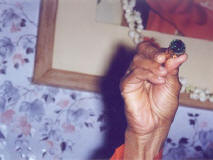
GV: Oops! The ring that Dasaratha gave?!!
AK: That is right. It was a diamond ring, and Swami was smiling as He looked around while materialising another ring – this time it was a sapphire ring that was presented to Lord Rama by His father-in-law, Emperor Janaka.
GV: I am told these rings are very big?
AK: Very big
indeed. I said, “Swami, it is almost the size of my wrist. How come this ring is
so big?” Swami replied, “Lord Rama was an Aajanubhau, meaning one of very tall
stature.
GV: Eight feet or so?
AK: Yes, Swami
then materialised the Mangalsutra or sacred wedding medallion, complete with the
sacred thread that holds the medallion. This was worn by Mother Sita at the time
of the wedding. I have also seen Swami materialising the chain worn by Ravana.
GV: Ravana?
AK: Yes, complete with 365 Shiva Lingas and a pendant at the bottom made up of three large Shiva Lingas, one yellow, one green and one blue. All the 365 were made of gold while the three in the pendant at the centre were made of crystal. This was the chain that Ravana wore.
GV: What happens to these jewels afterwards?
AK: They go back to SAI STORES (laughter). Swami also materialised a golden replica of the deer that captivated Sita, later landing her in trouble.
GV: Are you allowed to touch these objects?
AK: Yes, sir. On one occasion, Swami said, “Tomorrow is the wedding function of Balarama [brother of Krishna] and Revathi. All of you are invited for lunch!” Sure enough, on the following day, there was a fabulous lunch and in the afternoon Swami spoke about the marriage of Balarama with Revathi. And at the end He materialised a magnificent diamond-studded necklace with three or four rows of diamonds.
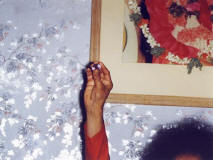 GV:
My GOD! How big was the necklace?
GV:
My GOD! How big was the necklace?
AK: About 15 cms.
At the centre of the arch-like necklace there was a Swan suspended by a gold
chain. The Swan was clear and you could look through its eyes, beak, stomach,
and so on. Every body started looking at it. Swami came to me and said, “Look,
look deep”. I did so and there in the middle of the stomach of that bird I could
see Bhagavan Baba in a reclining posture, the classic reclining posture of Lord
Narayana, reclining on His Thousand-hooded snake, Adisesha. That is what I saw.
It was absolutely fantastic. Swami also materialised the
CHOODAMANI or the ornament that Sita used to wear on her head. This was
the CHOODAMANI that Hanuman brought back as proof
of having met Sita, when he reported back to the Lord Rama.
GV: How do the boys feel on such occasions? They must be
transported to a different world.
AK: That is right, into a totally different world. They had come so close that they even took the liberty of almost pestering, saying, “Swami, let us see, let us see!” Swami gave ample opportunities for all to see these manifested objects at close quarters. He would keep them on the table so that everybody could later see at some leisure. Photographs would be taken and some of them are here in our MUSEUM also.
GV: Fantastic! Can you recall some really moving, spectacular, or heart-warming incidences? I am sure there must certainly have been a few of these.
AK: Well, there was an incident involving a student from the State of Kerala.
GV: How long ago did this incident take place?
AK: About six to eight years ago. Swami was showing special concern for this boy. We were wondering why? In fact, I was even jealous! Swami materialised a ring for him, a chain for him, a watch for him, and so on, and it seemed as if the whole trip was meant just for this boy! After a few days Swami materialised a pair of ear rings for that boy.
GV: Ear rings?
AK: Yes sir, ear rings that only girls wear. How is it that He materialised ear rings for the boy? We just couldn’t understand. The next day, Swami materialised another set of ear rings for the same boy. I thought to myself, “Swami I have three daughters, you can give me also one (laughter), why only to that boy, an unmarried fellow?” Then after a week, while delivering a Discourse, Swami said, “Many are wondering why Swami showed special concern to one particular boy. Some are specially curious to know why I gave ear rings to that boy. That boy lost his mother long back. I have been watching the boy crying and sitting in a corner. I called him close to Me and asked him about the reason. He then told Me about the death of his mother and how his mother wanted to present ear rings to her two daughters, that is the two sisters of this boy. Before his mother could do that, she died. Now, I am his Mother and also of those girls. Who else is there to care for them? That is why I materialised many things for that boy. You will seldom understand what I do. Whatever I do and say has got a deeper significance and inner meaning. Out of frustration, the boy’s father wanted to commit suicide. I made the boy’s father to come here, took a promise form him that he would not make any attempt to take his life. I am now taking care of the family. From that day onwards, the boy has started smiling.” That story really touched my heart. I said, “Swami you are the MOTHER of MOTHERS, dearer and nearer than the physical mother. You truly care for them”. I am sure none of us can really experience the depth, and the full intensity of Swami’s Love.
GV: Yes, that’s true. Swami has always that feeling towards us; only, we are not able to see that. Instead we go around making all sorts of silly statements like, “Swami is angry, so He will not talk,” and so on. We do not realise that Swami cannot be anything other than loving. In this context Swami says that God does not change and that it is only man who changes. One day he says God is good another day, he says God is not so great! The problem is always with man and never with God.
AK: Yes sir and He gives an example also. When we go by train to Bangalore, we say, as the city is approaching, “Bangalore is coming, Bangalore is coming”. And while departing from Bangalore, “We say Bangalore is gone”. Bangalore neither comes, nor goes. It is only we who go there and leave from there.
GV: Any memorable incidents that you can recall from your Kodaikanal trips?
AK: Yes. In Kodai, Swami often distributes all sorts of things, including peppermints, chocolate bars, and so on. Suddenly one day He said, “I am here distributing all these sweets and chocolates for you to eat, but there is one fellow who is not eating; instead he is dumping them all into his bag. Come on boys! Search everybody’s bags.” It was something like an income tax raid (laughter)! Then I said, “Swami, Bhagavan, why all this trouble? I am the one who is not eating. I am keeping them all in my bag.” Bhagavan then asked, “Why do you do that?” I replied, “Swami I have four children. They expect something from me. When I take back these most precious things like peppermints - whatever You give is most valuable for all of us – when I hand over these things, the children will jump in joy”. Swami said, “Oh, is that so?” He then told the boys, “Hereafter, you give Anil Kumar five pieces of sweets, four for his children to be kept in the bag, one for him to eat along with you and feel happy”. How can I ever forget that incident? I don’t recall anybody loving me more than Bhagavan Baba. In fact, this is the feeling of every devotee. This is the chance you have given me, sir, to describe my experience which is also the experience of millions of devotees the world over.
GV: What does Swami expect in return for all these? This is a sort of typical human question, because I do know that God does not expect any returns. In any case, let us hear what you have to say.
AK: Swami only wants us to learn from Him that just as He loves us, we must love our family, fellow human beings and God. And that is because God is Love and Love is God. Always Live in LOVE - that is His message.
GV: I am told that one year on Eswaramma’s day, Swami distributed blankets to the poor and then went out distributing to people who could not come to Sai Sruthi or the Mandir in Kodai. Were you present at that time? That seems to be a very unusual and moving incident. Why don’t you tell us about it?
AK: Yes, blankets were first distributed to all the poor people who assembled in Sai Sruthi that day, the 6th of May celebrated as Easwaramma day. Suddenly Swami said, “Let’s go!” He got into His car and the convoy started moving. On the way, whenever He saw poor people He stopped the car, got down and started personally distributing these blankets.
GV: Did He explain why?
AK: Bhagavan said you should do everything to care for the poor, the needy and the forlorn. This is a lesson that everyone should learn from Bhagavan. You should not expect them to come to you for service; instead, you must go to them, the Daridra Narayana or God disguised as the poor.
GV: Was it also
because some of them could not come because they were disabled?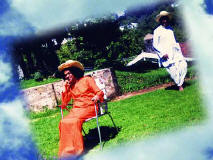
AK: Absolutely. Not only that sir, on our way to Kodaikanal, His car would sometimes suddenly stop whenever He saw a beggar or a village woman carrying a head-load of firewood. He would call them and give money; these are people who have never seen Swami before nor know anything about Him, much less that He was SAI BABA. He does things like that all the time. When I give Him a strange look, Bhagavan says, “I just cannot bear to see these poor people suffering like that”. Sir, I think you will be more thrilled and excited if I say, that in Kodai, Bhagavan purchases fluffy candy or candy puffs. Once He purchased about twenty five of them and took them in His car – His car was full of that stuff. Later He distributed them to VIPs. They were just amazed. Bhagavan then said, “Do you know why I bought them? Here, in Kodaikanal there are some aged people, they cannot move about and their children carry on their livelihood by selling these candy puffs. So when I purchase them, they go back home with money and give to their parents and that day is taken care of”. From that day, every body started purchasing candy puffs. For twenty five candy puffs you may have to pay about ten rupees, but Swami gave them five hundred rupees. I asked, “Swami, why so much?” He replied that it was not the price of candy that He was giving, but His Love! It is not the price of the candy, it is the love of Bhagavan towards them. I was really so happy when one day He called the boys and told them, “Boys, look here, you have seen Tibetans girls selling woollen garments. Everybody go and buy so that they will be happy!” When Sai Baba is in Kodai, they all have very good business. And then you must have heard about the straw hats.
GV: Straw hats? In fact I thing I have a photo of Swami and Narasimhamoorthy with straw hats.
(to be continued in the next issue)
The Kodaikanal Experience - Part III
of III
Rendezvous with Prof. Anil Kumar
 GV:
Straw hats? In fact I thing I have a photo of Swami and Narasimhamoorthy with
straw hats.
GV:
Straw hats? In fact I thing I have a photo of Swami and Narasimhamoorthy with
straw hats.
AK: Swami got down from His car one day and purchased a straw hat and put it on His head. When Swami wore that hat, the whole Kodakanal was soon full of these straw hats. Bhagavan said, “See they now have plenty of money and are very happy”. These are all poor people and they wait for Bhagavan to arrive in Kodai because with Swami, Lakshmi [the goddess of Wealth] follows and takes care of their life. And one day, Swami called two servant maids, very poor ladies, and gave them silk sarees. I was wondering why.
GV: How did He pick these two women?
AK: They were working there in the Ashram, washing utensils. Swami gave them silk sarees. I asked, “Swami, silk sarees for servant maids?” Swami looked at me and said, “It is I who give; why should you cry (laughter)? Are you jealous?” I replied, “No, Swami they cannot afford these silk sarees, I don’t know why You give them such expensive clothes?” He replied, “So that they may wear them and attend marriages and such functions. When they visit relatives wearing these sarees, they would say, ‘Sai Baba gave this’. That would give them a lot of joy. Why do you think like that?” Sai loves everybody and His Love is uniform.
GV: He always tries to make people happy.
AK: Extremely
happy.
.
GV: The message is that we also should try to do that. Tell me
how Swami, in subtle ways, teaches the students. I ask this because you say
living with Swami is an experience. What are the lessons?
AK: He watches
how every student conducts himself and immediately points out deficiencies.
GV: X-ray eyes!
AK: If there is any mistake, He will notice it. To begin with, dining-table manners, how one should conduct himself while dining with others. Usually boys serve first. There are so many points to consider here - how to serve, how to receive guests, how to extend hospitality, how to talk to elders, how to dress, all sorts of minute details. These days, parents do not have the time to observe and teach. They are busy in their own way. But Bhagavan is more than a parent. He cares for His boys.With the result the boy becomes so good that his parents would wonder whether he was the same child. When they leave home the boys are of one type while when they come back they are totally transformed. That is the transformation that Swami produces.
GV: Did you feel it was kind of very strange that God is doing all this?
AK: Well, God comes down for both for reformation and transformation. Reformation of the world and transformation of the inner being.
GV: You say Swami selects boys with talents. How does He put these talents on display in Kodaikanal?
AK: In many ways. During Bhajans He will ask them to sing. Later, boys would be asked to play on musical instruments. Boys with talent for speaking would be asked to give talks.
GV: Are there some KAVI SAMMELANS or sessions devoted to poetry?
AK: The Sathya Sai Institute is rather unique in that we have students from many parts of the country. We have all together about fifteen languages or so. Thus each student would compose a poem or a song in his own language. One day Swami would organise this KAVI SAMMELAN, or an assembly of poets, rendering their compositions. Swami will tell every boy, “Come on, sing a song or recite a poem in your mother tongue.” And while the boy is doing so, Swami would translate, add explanations and interpretations, besides correcting the boy wherever he went wrong.
GV: Translating? If it is a Bengali poem ?
AK: He translates all languages.
GV: Then, why does He need you?! Anyway, this is amazing. Now tell us something about the picnic. That must be something very unusual.
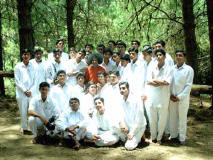 AK: Swami
will take the boys to a nearby mountain area in Kodaikanal. The party would go
there with food packets. All would sit in the form of a circle and Swami would
start joking on the dress and the walking style of boys, besides imitating them,
much to the amusement of every body. It is all quite light-hearted. Of course,
when He pokes fun, it is really to help the boy to correct his mistakes. He says
to one boy, “You are walking like a lady,” and that boy would know how to walk
properly. He will look at another boy and ask, “Why you are so fat? You had
better do some exercises,” making everybody laugh. After some bantering like
this come the games. Small slips of paper are prepared with various instructions
written on them, such as: You must dance, you should sing, you must crack a
joke, and so on. The number of slips so prepared is equal to the number of
people seated around in a circle. A slip is put in a box and the box is passed
around while music plays. Suddenly the music is stopped and the boy holding the
box at that moment has to do exactly what is written on the slip inside.
AK: Swami
will take the boys to a nearby mountain area in Kodaikanal. The party would go
there with food packets. All would sit in the form of a circle and Swami would
start joking on the dress and the walking style of boys, besides imitating them,
much to the amusement of every body. It is all quite light-hearted. Of course,
when He pokes fun, it is really to help the boy to correct his mistakes. He says
to one boy, “You are walking like a lady,” and that boy would know how to walk
properly. He will look at another boy and ask, “Why you are so fat? You had
better do some exercises,” making everybody laugh. After some bantering like
this come the games. Small slips of paper are prepared with various instructions
written on them, such as: You must dance, you should sing, you must crack a
joke, and so on. The number of slips so prepared is equal to the number of
people seated around in a circle. A slip is put in a box and the box is passed
around while music plays. Suddenly the music is stopped and the boy holding the
box at that moment has to do exactly what is written on the slip inside.
GV: Everyone gets a slip including Swami?
AK: Including Swami.
GV: Oh, My God!
AK: It so happened, Prof. Sampath was there in the group. He got a slip. Prof. Sampath is a wonderful person, a well-known scientist, a man of ready wit and humour, and a personification of human values. When Prof. Sampath’s turn came and he looked at the slip inside, it said, “You should sing a song.” Professor said “Swami, I cannot sing.” Swami said, “I cannot help you. You have to follow the rules of the game and do just what your slip says”. Prof Sampath then pleaded, “Swami, can I be exempted?” Laughing merrily, Swami said, “No, no, you should do what is said in the chit”. Professor started singing in his coarse voice; he was not used to singing at all, and every body started putting their fingers into their ears, and plugging their ears so that they don’t have to hear him. That added to the fun and frolic. Every body was reeling with laughter.
GV: I remember Prof. Sampath telling me this story. He did it all in good humour. He is a very sportive person; a wonderful man. So if you were to summarise this extraordinary experience that Swami gives in Kodaikanal, how would you do it?
AK: Well Sir, in Kodaikanal we have a number of opportunities to put any number of questions to Bhagavan covering all topics under the sun. Boys also get influenced by what they see. When they go out with Bhagavan, they see thousands of devotees waiting for Him by the roadside. That is when they realise how lucky they are! They say to themselves: “These people have been waiting since the early hours of morning in the cold, to have just a glimpse of Bhagavan. We, on the other hand, are all the time with Swami. We are so very fortunate.” That is the first reaction. Number two, Swami watches a boy eating a particular item. He sees to it that he is served extra. And how He cares for them! Swami’s extra-ordinary concern and love naturally touch the boys, and that is what brings about the transformation. They ask: “What shall I do in return, for all the time He spends with me, and for all the concern, love that He shows me? How am I to repay?”
GV: What does Swami say about that?
AK: He says: “I don’t want anything from you. All I want from you is for you to get a good name for yourself, for your parents and for your Institute - that is the way of expressing gratitude to Bhagavan”. That is what HE says, “Do good, be good, see good,” - that is the quintessence of His message.
GV: It is so unimaginable. This broadcast would be heard all over the world and so literally you have brought Kodaikanal experience to thousands of people all over the world. We are very grateful to you from Radio Sai, and we do hope we will have more opportunities to talk to you on this subject. After your next Kodai trip, you had better report immediately to our studio here to tell us all about it!
AK: I eagerly look forward to that opportunity.
GV: At least for that sake, I hope you will be taken in the next trip! Thank you very much and Sai Ram
AK: Thank you,
and Sai Ram.
Also read: All about Kodaikanal Ashram - Kodaikanal Experience
Source: http://www.radiosai.org/